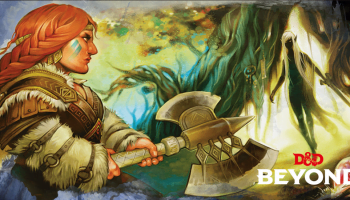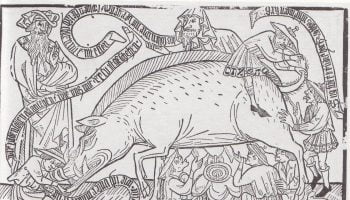This introduces a special focus in our ongoing series on Race, Racism and the Middle Ages. You can find the rest of our special series on Race, Racism and the Middle Ages here.
Thus far in The Public Medievalist’s series on Race, Racism, and the Middle Ages, we have looked at how those on the far-right—both today and in the past—have had a “vile love affair” with the Middle Ages. We have looked at some of the multicultural and multiracial melting-pot societies that existed in the Middle Ages (and their extraordinary accomplishments). We have examined Arab Muslims and sub-Saharan Africans and their previously lesser-recognized presence in the Middle Ages. We have even explored some of the fundamental questions of what race actually is (and is not), how medieval people thought about race, and how our present-day ideas of race came to be.
But thus far, we have yet to really delve into the experiences and contributions of Jewish people in the Middle Ages. Jews, Anti-Semitism, and the Middle Ages is a complex subject, and not one to be taken lightly. You might wonder why, in a series fundamentally about race, we are discussing Jews. We are discussing them because the Jewish experience in the Middle Ages—and the oppression that the Jews faced—was instrumental in the formulation of how race is understood today, not just for Jews, but for all races.
There is open debate even today among Jews and others as to whether Judiasim is a religion, a race, or both. Some note that since there is nothing barring a person from converting to Judaism if they are so inclined and no reason a Jewish person might not convert to Christianity or Buddhism it is purely a religion. Race is seen to be a far more permanent, inherent characteristic—something Rachel Dolezal ran up against when she identified and represented herself as a black person despite having white parents. Converting to blackness is not as simple as converting to Judaism. On the other hand, there has been avid debate among Jewish geneticists over whether the Jews can be understood as a singular people.
And further complicating matters, the rise of the racist neo-fascist “alt-right” and the election of Donald Trump has renewed anxieties among some Jews and caused them to openly wonder whether they are—or should consider themselves—“white” anymore. The Atlantic published an article whose title bluntly asked “Are Jews White?” As Sara Weissman wrote in Scribe back in January 2017:
Now that our President-elect won on campaign promises to deport “bad hombres,” ban Muslim immigration, and expunge crime with stop and frisk, it’s high time for American Jews to side with minorities. People of color aren’t blessed with a choice—but, as far as we know, at this moment in history, we are. We can embrace the label recently bestowed on us by the whims of the white privilege fairy, or we can realize what her transient gifts deny others. We can stand with power because it makes us feel safe, or we can find more steadfast solidarity in standing with other communities that face discrimination under this administration.
So, as a white-looking Jew, am I white right now? In Trump’s America, I have no idea. But I’m choosing to answer, “Not anymore.”
As a previous article in this series has explored, racial concepts and categories are fundamentally arbitrary, social and historical (meaning that they have changed over time). They lie somewhere between an identity that you claim for yourself, and an identity that others in society ascribe to you. Jews have represented themselves—and been understood and treated by others—as a separate people since Antiquity. Interestingly, in the ancient world it was far more common for religion and race (or, since “race” was not exactly a concept, the sense of an identity that defines a group as a cohesive “people”) to be closely linked. But the fundamentally evangelizing nature of Islam and Christianity helped decoupled race from religion over time.
A Special Focus

Over the next several weeks we will feature articles about the deep roots of anti-Semitic (or perhaps more accurately, anti-Jewish) thought, the troubled history of the Jews in medieval Europe, and how medieval anti-Semitic ideas are recycled in racist discourses today.
It has also always been the goal here at The Public Medievalist to offer a counterbalance to the prevailing narrative—to reveal past worlds in all their nuance and complexity. And so, we will also be discussing those places and times where Jews thrived and were treated just as anyone else. We will reveal the stories of several medieval Jewish people who made an indelible mark on the world. And we will lift up those non-Jews who placed themselves in harm’s way in order to protect the Jews in their communities.
Anti-Semitism remains a crucially important topic. Since 2016 and now into 2017, the Anti-Defamation League has been tracking a sharp spike in anti-Jewish vandalism and assaults across the US. In the UK, the Community Security Trust reported a record number of incidents of anti-Jewish hate in 2016. In Hungary, the Central European University has been shuttered by the government in large part because its chief benefactor, George Soros, is a liberal Jew. This is one of the parts of the Middle Ages that we should have left far behind. Sadly, that is clearly not the case. But we hope that through our work, The Public Medievalist might help to enlighten our readership to the deep roots of this monster that has once again reared its disgusting head. It is only armed with this knowledge that we can hope to finally to slay this monster once and for all.
The Public Medievalist does not pay to promote these articles, so we would love it if you shared this with your history-loving friends! Click to share with your friends on Facebook, or on Twitter.





Very dubious about this given your citation of Shlomo Sand, who is virtually universally recognized as a hack.
Hi Ilana. Thanks for your feedback, and, after looking into it, you’re right. Professor Sand’s work does not seem credible enough for us to quote him as uncritically as we did (even if it was a requote from The Forward). I’ve removed the quotation from him.